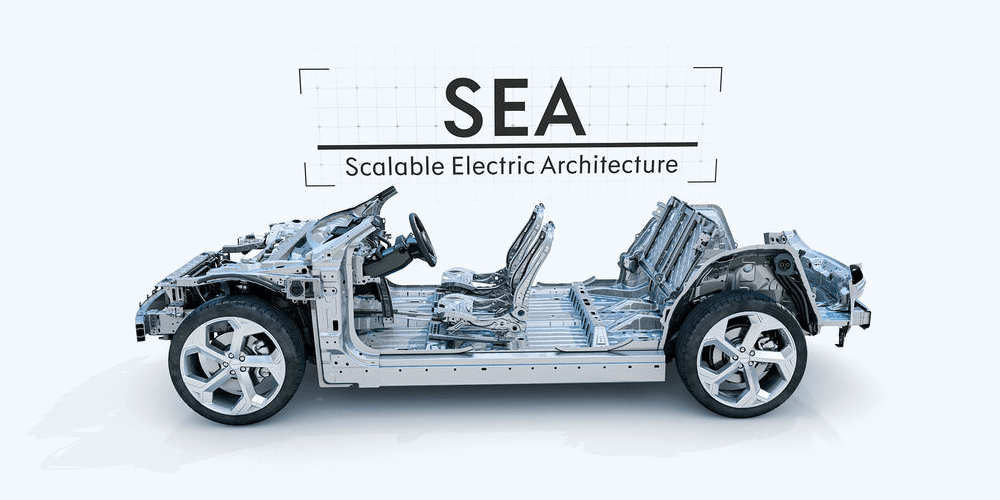New details on the scope of Geely SEA e-platform
Details on the scope of Geely’s SEA (Sustainable Experience Architecture) electric platform have come to light. According to a media report, there will be five versions of the electric platform for all relevant vehicle classes, and these will always have two battery options.
In the future, a number of electric models from different brands will be built on the SEA platform, which was unveiled in 2020, because the Chinese carmaking giant’s holdings are known to be widely diversified. There are already concrete indications that the SEA will also be used at Lynk & Co. and Zeekr, and at Volvo Cars and Smart, for example, as well as at the Chinese tech group Baidu.
According to the generally quite reliable car news website Paultan, Geely has announced some interesting details about the platform at an event for media representatives in Malaysia. Among others, the group sent SEA chief engineer Kent Bovellan as a representative.
It now appears that there will be five versions of the electric platform for all relevant vehicle classes. It was only generally said that the SEA could produce vehicles from the A to E segment and even light commercial vehicles. This means the SEA1 is for D to F segment e-cars, SEA2 for B to D segments, SEA Entry (SEA-E) for A-segment small cars, SEA Sport (SEA-S) for sportier models, and SEA Commercial (SEA-C) for vehicles between 3.5 and 5.5 tons, including minivans and pickup trucks.
All models will be offered with at least two battery options, with SEA-E vehicles coming with 58- and 68-kWh batteries and larger ones like the SEA1-based Zeekr 001, the debut electric vehicle Geely’s recently launched premium electric brand, with either 86- or 100-kWh capacity. The ranges are expected to be between 460 and 700 kilometres, depending on the segment, although these are still NEDC values as is customary in China.
The platform is also expected to support flexible positioning of single or multiple motors for front-, rear- or all-wheel-drive configurations. It was already known from Lynk & Co that the SEA provides for two electric motors per axle – i.e. four for the all-wheel-drive version and two for rear-wheel drive. The Zeekr oo1 has the same all-wheel-drive configuration. While general performance data on the SEA is still lacking, the electric car provides an orientation: According to the manufacturer, it should have a maximum output of 400 kW and a torque of over 700 Nm, keeping in mind that this is based on the SEA1 for the large vehicle classes D to F.
Paultan also writes that the SEA platform will allow the installation of a range extender that “will not take the form of a conventional car engine, but will instead be positioned in a smaller form at the rear of the vehicle in place of an electric motor.” In this case, the front engine will power the vehicle. The range achievable by the range extender is said to be around 1,000 kilometres, according to NEDC.
Meanwhile, there is still no concrete kW information on the charging power. Only this much: In conjunction with a 400-volt system, a charging process from ten to 80 per cent is expected to take around 30 minutes; an upgrade to 800 volts is expected to reduce the time to around 20 minutes. The batteries for the SEA platform, supplied by CATL, are said to allow 200,000 kilometres without sacrificing range. Up to two million kilometres are possible before capacity drops to 80 per cent, the report continues.
Finally, Paultan cites some interesting landmarks about the individual platform variants. For example, the SEA2 allows wheelbases of 2,650 mm to 2,900 mm, while that of the SEA1 is around three meters (around said Zeekr 001). The smallest model developed on the SEA-E is currently said to have a wheelbase of 2,550 mm. Geely is currently not planning any mini-vehicles at the SEA.
All models are also to be of unibody construction, with the battery pack itself installed in the underbody being used to reinforce the structure. To produce very flat vehicles and thus create lower footwells, battery cells are to be partly relocated to the centre tunnel. This applies in particular to the SEA-S platform for the creation of sporty electric cars, which, according to chief engineer Kent Bovellan, are supposed to compete with vehicles from Audi and Porsche’s Premium Platform Electric (PPE).
In terms of sprinting ability, the SEA-S is working toward a target acceleration time of about 2.8 seconds. The approach of the larger vehicles based on the new platform is somewhat more leisurely: The Zeekr 001 manages the sprint from zero to 100 km/h in 3.8 seconds.
Reporting by Cora Werwitzke





0 Comments